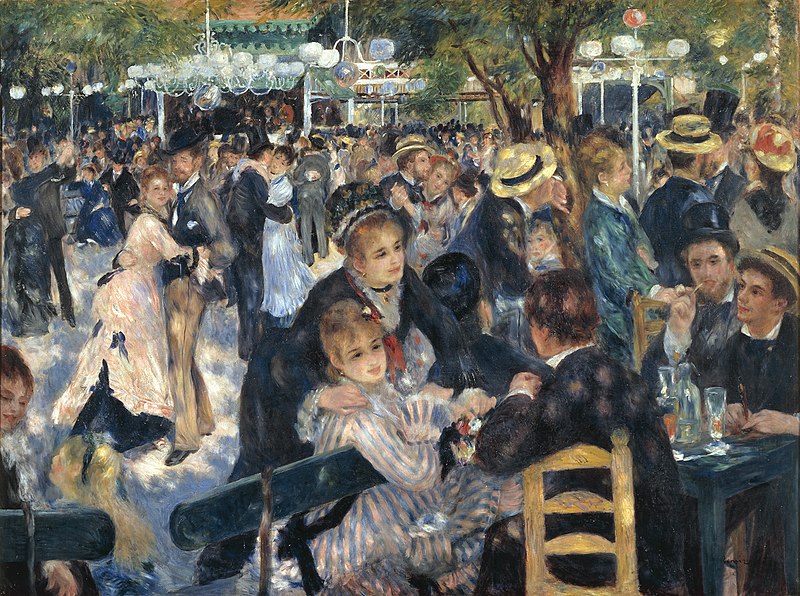
This past week saw the birthday of Pierre Auguste Renoir (February 25, 1841), one of my favorite artists. He had a very long career and was a prolific artist with thousands of works. While there is no way I can do him justice in this little blog, I’ll try to show some of his work that I admire.
Renoir was born in Limoges but, when he was very young his father, a tailor, moved the family to Paris. Tellingly, the location of their new home, in proximity to the Louvre, would have a major impact on Renoir’s future.
He had a talent both for drawing and singing but, at age 13, the family’s financial circumstances forced him to withdraw from school and work in a porcelain factory. He was good at his work but found it boring and often wandered away to the galleries of the Louvre. The owner of the porcelain factory recognized is talent and Renoir started taking lessons. While studying he met Alfred Sisley, Frédéric Bazille and Claude Monet. At time he didn’t have enough money to buy paint. Nevertheless, he began showing paintings at the Paris Salon.
One of his first successful paintings was of Lise Tréhot, his lover at the time.
Renoir’s early work was influenced by the colorism of Delacroix and the realism of Courbet and Manet as well as their use of black as a color. Another example of Renoir’s early work is this painting of Diana, which shows the influence of Courbet’s realism. Lise Tréhot is again the model.

The bright green colors and red accents are considered to reflect the impressionism that Renoir would become associated with a few years later.
In the late 1860s, he and his friend Claude Monet, through painting light and water en plein air, discovered that the color of shadow is not black or brown but reflects the color of the objects around them. The worked side-by side frequently and often painted the same scene. I like the contrast and similarity in their styles as shown in these two paintings.


His impressionist period was prolific. One of his most famous impressionist paintings is Dance at Le Moulin de la Galette which depicts an open-air dance garden close to where he lived. It’s full of action, color and light.

In 1881 he took a trip to Italy and saw works by Raphael and other Renaissance painters which convinced him he was on the wrong path. He began painting in a more severe style trying to return to classicism. He painted works such as ‘The Large Bathers” which emphasized line and form.

Notably (to me at least) two of the models for this painting were his lovers at one time or another. Suzanne Valadon on the left was a long time model for him who became a noted painter in her own right and Aline Charigot on the right who modeled for many of his paintings and became his wife.
After 1890, he changed direction again and his work showed dissolved outlines and thinly brushed work. You can see the contrast of styles between The Large Bathers above and ‘Girls at the Piano’ below which he painted in 1892.

In the mid-1890s, Renoir developed rheumatoid arthritis. in 1907 he moved his family to the south of France to take advantage of the warmer climate. He continued painting during the last 20 years of his life even as the arthritis severely limited his mobility. Renoir died at Cagnes-sur-Mer on 3 December 1919.
The love of his life was Aline Victorine Charigot who was a dressmaker. She met Renoir when she was twenty and he was nearly forty and started modeling for him. She gave birth to his first son, Pierre, in 1885, and married Renoir in 1890. They had two other sons, Jean born in 1894 and Claude in 1901.
She modeled for Renoir over a long period, 1880 to 1915. She cared for her husband as his arthritis became severe. After Claude’s birth she developed diabetes but hid this from her husband. Pierre and Jean were drafted into the army during World War I and both were injured, Jean seriously. Aline died of a heart attack in Nice after a visit to Jean in the hospital in 1915.
Charigot appears in many of Renoir’s paintings. In ‘Luncheon of the Boating Party’ at the top of this post, she is the woman playing with the dog on the far left. Here are some more of his paintings that include her.






Renoir was, to me, an amazing artist. The largest collection of his work is at the Barnes Foundation in Philadelphia. Go and see it.

























































Comments